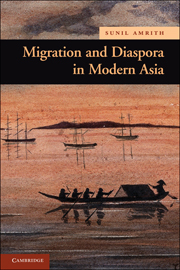Book contents
- Frontmatter
- Contents
- List of Plates, Tables, and Maps
- Acknowledgements
- Select Timeline
- Glossary
- Maps
- Introduction
- 1 Asia's Great Migrations, 1850–1930
- 2 The Making of Asian Diasporas, 1850–1930
- 3 War, Revolution, and Refugees, 1930–1950
- 4 Migration, Development, and the Asian City, 1950–1970
- 5 Asian Migrants in the Age of Globalization, 1970–2010
- Conclusion
- Guide to Further Reading
- Index
3 - War, Revolution, and Refugees, 1930–1950
Published online by Cambridge University Press: 05 June 2012
- Frontmatter
- Contents
- List of Plates, Tables, and Maps
- Acknowledgements
- Select Timeline
- Glossary
- Maps
- Introduction
- 1 Asia's Great Migrations, 1850–1930
- 2 The Making of Asian Diasporas, 1850–1930
- 3 War, Revolution, and Refugees, 1930–1950
- 4 Migration, Development, and the Asian City, 1950–1970
- 5 Asian Migrants in the Age of Globalization, 1970–2010
- Conclusion
- Guide to Further Reading
- Index
Summary
Why should we expect that we're going to spend the rest of our lives here? There are people who have the luck to end their lives where they began them. But this is not something that is owed to us. On the contrary, we have to expect that a time will come when we'll have to move on again. Rather than be swept along by events, we should make plans and take control of our own fate.
Amitav Ghosh, The Glass PalaceIn the 1930s, patterns of inter-Asian migration broke down and went into reverse. The middle decades of the twentieth century were a period of disconnection, shattering many of the links between East, Southeast, and South Asia. The 1920s marked the height of migration in Asia; not until the 1990s would levels of migration in Asia reach the same level. By the 1930s, and for the first time since the 1870s, the number of Indian and Chinese migrants returning home outstripped the number of new arrivals in the ports and plantations of Southeast Asia. Just as the circuits of migration began to reconstitute themselves with the first signs of economic recovery, a new age of global warfare intervened, producing mass migration of an entirely different kind: the mass migration of refugees, in flight from catastrophic violence and social collapse. The mid-twentieth century, in Asia as elsewhere, was the age of the refugee.
- Type
- Chapter
- Information
- Migration and Diaspora in Modern Asia , pp. 89 - 116Publisher: Cambridge University PressPrint publication year: 2011



